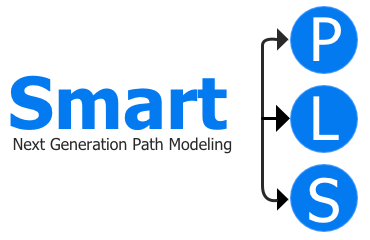Choosing Between PLS-SEM and CB-SEM
A good starting point for distinguishing and choosing between PLS-SEM and CB-SEM represents the "five perspectives" article by Rigdon, E. E., Sarstedt, M. and Ringle, C. M. 2017. On "Comparing Results from CB-SEM and PLS-SEM. Five Perspectives and Five Recommendations." Marketing ZFP, 39(3):4-16.
In addition, to decide when choosing between PLS-SEM or CB-SEM consider the study by Sarstedt, M., Hair, J. F., Ringle, C. M., Thiele, K. O. and Gudergan, S. P. 2016. "Estimation Issues with PLS and CBSEM: Where the Bias Lies!" Journal of Business Research 69(10): 3998-4010.
You may find the rules of thumb for choosing between PLS-SEM and CB-SEM useful -- see Hair, J. F., Hult, G. T. M., Ringle, C. M., and Sarstedt, M. 2022. A Primer on Partial Least Squares Structural Equation Modeling (PLS-SEM). 3rd Ed. Thousand Oaks, CA: Sage useful.
Use PLS-SEM when
- The goal is predicting key target constructs or identifying key “driver” constructs.
- Formatively measured constructs are part of the structural model. Note that formative measures can also be used with CB-SEM, but doing so requires construct specification modifications (e.g., the construct must include both formative and reflective indicators to meet identification requirements).
- The structural model is complex (many constructs and many indicators).
- The sample size is small and/or the data are nonnormally distributed.
- The plan is to use latent variable scores in subsequent analyses.
Use CB-SEM when
- The goal is theory testing, theory confirmation, or the comparison of alternative theories.
- Error terms require additional specification, such as the covariation.
- The structural model has circular relationships.
- The research requires a global goodness-of-fit criterion.
Also take a look at recommendations by Hair, J. F., Risher, J. J., Sarstedt, M. and Ringle, C. M. 2019. "When to Use and How to Report the Results of PLS-SEM." European Business Review, 31(1):2-24.
When to choose PLS-SEM according to Richter, N.F., Cepeda Carrión, G., Roldán, J. L. and Ringle, C. M. 2016. "European Management Research Using Partial Least Squares Structural Equation Modeling (PLS-SEM): Editorial." European Management Journal 34(6): 589-597.
"The question that arises is the following: Why and when should PLS-SEM be used? Wold (2006) provides, among others, the following key reasons for using PLS-SEM: (a) the PLS-SEM approach has a broad scope and flexibility of theory and practice; and (b) a PLS path model develops through a dialogue between the investigator and the computer, in that tentative model improvements such as the introduction of a new latent variable, an indicator, and an inner model relation, or the omission of such an element are easily and quickly tested for predictive relevance. Moreover, prediction-oriented analyses, complex models, and secondary/ archival or big data motivate the use of PLS-SEM (Gefen, Rigdon, & Straub, 2011; Rigdon, 2012, 2014). Additional reasons, suggested by Sarstedt, Ringle, and Hair (2016) and Rigdon (2016), are the use of composites that represent formatively measured latent variables, the use of small sample sizes due to a small population, applying PLS-SEM latent variable scores in subsequent analyses, and endeavoring to overcome factor-based SEM's limitation by mimicking the results of common factor models (i.e., by using consistent PLS approaches; Bentler & Huang, 2014; Dijkstra & Henseler, 2015b).
Wold (2006) notes that in large and complex models with latent variables, PLS-SEM is “virtually without competition.” It has not only drastically reduced the distance between subject matter analysis and statistical technique but also reinvented the modeling of complex systems in domains with access to a steady flow of reliable data. In this context, Wold (1982), and later Chin (1998), expected PLS-SEM to be widely used across disciplines with rich data, such as classical (political) economics, education, health care and medicine, political science, and chemistry. However, management and other social sciences have traditionally had limited access to rich data because surveys that are subject to several restrictions (e.g., the number of questions) have usually provided most of the relevant data. With the ever-increasing availability of secondary data (e.g., from company databases, social media, and customer tracking), this situation has started to change dramatically. In fact, secondary and/or big data and PLS-SEM's soft modeling approach fit hand in glove: “Soft modeling is primarily designed for research contexts that are simultaneously data-rich and theory-skeletal.” (Wold, 1982, p. 29; also see Rigdon, 2013)." (p. 590).
For non-useful argument when to use and not to use PLS-SEM see the article by Rigdon, E. E. 2016. "Choosing PLS Path Modeling as Analytical Method in European Management Research: A Realist Perspective." European Management Journal 34: 598-605.
Other Sources
- Hair, J. F., Hult, G. T. M., Ringle, C. M., Sarstedt, M. and Thiele, K. O. 2017. "Mirror, Mirror on the Wall: A Comparative Evaluation of Composite-based Structural Equation Modeling Methods." Journal of the Academy of Marketing Science, 45(5), 616-632.
- Hair, J. F., Ringle, C. M., and Sarstedt, M. 2011. "PLS-SEM: Indeed a Silver Bullet." Journal of Marketing Theory and Practice 19 (2): 139-151.
- Hair, J. F., Ringle, C. M., and Sarstedt, M. 2012. "Partial Least Squares: The Better Approach to Structural Equation Modeling?" Long Range Planning 45 (5-6): 312-319.
- Fornell, C. G., and Bookstein, F. L. 1982. "Two Structural Equation Models: LISREL and PLS Applied to Consumer Exit-Voice Theory." Journal of Marketing Research 19 (4): 440-452.
- Jöreskog, K. G., and Wold, H. O. A. 1982. "The ML and PLS Techniques For Modeling with Latent Variables: Historical and Comparative Aspects." In Systems Under Indirect Observation, Part I. Eds. H. O. A. Wold and K. G. Jöreskog. Amsterdam: North-Holland, 263-270.
- Lohmöller, J.-B. 1989. Latent Variable Path Modeling with Partial Least Squares. Heidelberg: Physica.
- Reinartz, W. J., Haenlein, M., and Henseler, J. 2009. "An Empirical Comparison of the Efficacy of Covariance-Based and Variance-Based SEM." International Journal of Research in Marketing 26 (4): 332-344.

